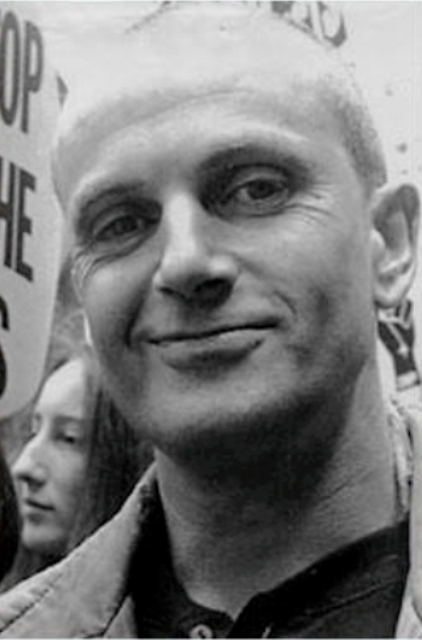Hero #065: Barry Horne … (03/30/16)
Barry Horne was an English animal rights activist who literally gave his life for the cause in 2001 … Horne first came to public attention in 1988, when he tried to rescue Rocky, a bottlenose dolphin who had been kept in a small concrete pool for almost 20 years at Marineland in Lancashire. Horne and four other activists planned to move the dolphin from his pool to the nearby ocean, and yet aborted their nighttime rescue after realizing that the logistics of the mission were beyond them. Undaunted by their initial failure, Horne and his compatriots continued with their mission to free Rocky, and in 1989 launched a campaign that picketed the dolphinarium, handed out leaflets to tourists, organized rallies, and lobbied the local council. The subsequent loss of ticket sales caused the management of Marineland to agree to sell the dolphin (for a sum that was subsequently raised with the help of a number of animal charities). As a result, Rocky was first transferred to an 80-acre lagoon reserve in the Caicos Islands, and then ultimately released, where within days he was seen swimming with a pod of wild dolphins. Peter Hughes of the University of Sunderland cites Horne’s campaign as an example of how the active promotion of animal rights created a paradigm shift in the UK, and claimed that as a result there are now no captive dolphins in the UK whatsoever.
Buoyed by his success, Horne ramped up his efforts to liberate the innocent. In 1990, together with Keith Mann and Danny Attwood, he was part of a small Animal Liberation Front (ALF) cell that raided a British company in Cambridge (Interfauna) that supplies laboratory animals to vivisectionists. The activists entered the area where Interfauna caged their animals by punching holes in the roof, and then saved 82 beagle puppies and 26 rabbits from lives of immense pain & suffering. A vet who was an ALF supporter removed the tattoos from the dogs’ ears, and they were dispersed to new homes across the UK.
At this point Horne went primarily solo and began to ramp up the intensity of his actions, causing the authorities to monitor him quite closely. He knew they were doing so, of course, and he knew he would one day be caught, and yet he saw animal rights activism as a war against a truly vile oppressor, and he was willing to become a casualty therein.
He was arrested in July of 1996 and charged with planting two small incendiary devices in the Broadmead shopping centre in Bristol. While in jail for these offenses, Horne began what would end up being a series of long hunger strikes designed to effectuate the end of vivisection in England – a tactic that was not without success. His first hunger strike (in early 1997) lasted for 35 days. It pressured the Labour Party into publicly promising that they were “committed to a reduction and an eventual end to vivisection,” and it inspired a number of animal rights activists to liberate many hundreds of cats, beagles, and rabbits from abusive facilities throughout the UK … Horne’s second hunger strike (in the late summer of that same year) lasted for 46 days, and sparked yet another increase in animal liberation actions — including protests in London, in Southhampton, at The Hague, in Cleveland (Ohio), and at Umea University in Sweden. 400 people also marched on Shamrock Farm (a primate holding facility), 300 more blockaded Wickham Laboratories, and Labour Party offices were picketed. In addition, a Newchurch guinea pig farm was raided and over 600 guinea pigs were freed.
Despite these successes, however, it was Horne’s third hunger strike (while serving his final, 18-year sentence for ALF-related arsons) that gained both himself and his cause worldwide notoriety, bringing the issue of animal experimentation to the forefront of British politics, and inspiring activists around the world to once again ramp up their liberation actions, as well as threaten more massive disruptions should he die. It was at this time, in December of 1998, that Barry Horne engaged in a 68-day hunger strike – one that left him with permanent kidney damage and failing eyesight, and one that ultimately led to his death of liver failure three years later — during yet another hunger strike for the animals.
“It is always easier to see the reasons why we cannot succeed; always easier to shrug our shoulders and believe the best we can do is offer meek token gestures … And yet we should never be afraid to succeed or believe we can succeed … With this hunger strike I am saying to the government of this country that we want it all and that we will accept nothing less than success. And how can we possibly ask for less? For to do so is to condemn thousands of animals to a life of suffering and premature death … The fight is not for us, not for our personal wants and needs. Rather, it is for every animal that has ever suffered and died in vivisection labs, and for every animal that will suffer and die in those same labs unless we end this evil now. The souls of the tortured dead cry out for justice, while the cry of the living is for their freedom. We can create that justice, and we can deliver that freedom. The animals have no one but us. We must not fail them.” ~ via Barry Horne





 ;
;